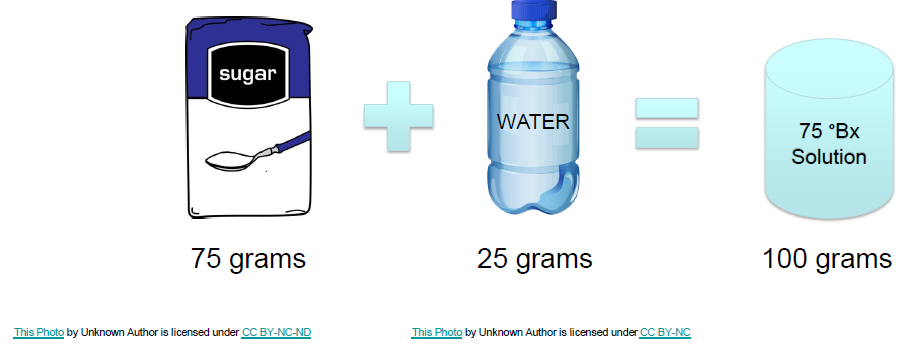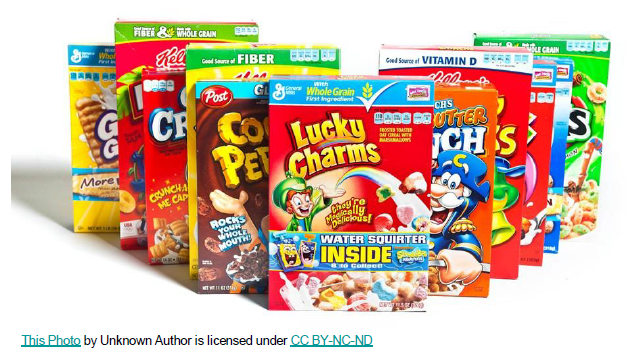41 Product Formulation and Calculation
Michael Hrycay
Learning Objectives
Calculate amounts of raw materials / in-process products required based on formula and units of storage
Introduction
When creating food products in large quantities, it is necessary to have a recipe that is followed exactly. Following a recipe requires measuring quantities, and the measure of quantity of sugar in water is called Brix. Carefully controling the amount of sugar in a solition is important both for flavour, and other considerations such as texture, or jelling.
- Brix, or degrees Brix (°Bx) represents the sugar content of an
aqueous solution - Brix is a mass (weight) measure, NOT volumetric
- Examples:
- One degree Brix is 1 gram of sucrose in 100 grams of solution
- 50 degrees brix is 50 grams of sucrose in 100 grams of product, or
50 grams of sugar dissolved into 50 grams of water (50 grams sugar
plus 50 grams of water = 100 grams of product, or solution)
Example
What are the contents of 100 grams of a 75 °Brix solution?

Example
What is the °Bx of a solution that is made up of 10 Kg of sugar and 100 Kg of water?


Juice Concentration Dilution Calculation
- A typical Brix concentration of juice is 10 to 12 °Bx
- To create a juice of 12 °Bx from an 80 °Bx concentrate, you first need to determine how much sugar you want in the final solution
- Using an example batch size of 100L:
1g of water = 1 mL of water
100L of water = 100 Kg of water
Sugar required = 0.12 * 100 Kg
Therefore, the final juice requires 12 Kg of Sugar
Concentrate Quantity
- How much of the 80 °Bx concentrate is needed to have 12 Kg of sugar?
12/0.8 Kg = 15 Kg
Therefore, 15 Kg of concentrate is needed to have the 12 Kg of sugar.
However, the 15 Kg of concentrate is 12 Kg of sugar AND 3 Kg water.
Water Quantity Determination
Batch Size = 100 Kg
100 Kg – 15 Kg (Concentrate) = 85 Kg Water
Therefore, using an 80 °Bx concentrate, 15 Kg of concentrate and 85 Kg of water is required.
Food for Thought
Cereal coatings are 80 to 85-degree Brix solutions. That is a LOT of sugar!
 How could you make an 85 °Bx cereal coating out of sugar and water?
How could you make an 85 °Bx cereal coating out of sugar and water?
- Every 100 grams of the solution has 85 grams of sugar and 15 grams of water!
Example
How much water should a 50 Kg bag of sugar be dissolved in to create an 85 °Bx solution?
Solution
An 85°Bx solution consists of the following:
- 85g of sugar and 15g of water. (Verify: °Bx = (85/(85+15))*100 = 85°Bx)
- Therefore, you can set up a ratio:
 Where “X” represents how much water is needed
Where “X” represents how much water is needed
- You can then cross-multiply to determine x:
X = (15*50)/85 = 8.82 Kg of Water
Practice Questions
- Calculate how much apple concentrate (55 °Bx ) and water is
required to produce 163Kg of juice which is 12 °Bx. Round your
answers to one decimal place. Answer: Concentrate = 35.6 Kg, Water = 127.4 Kg - A batch of juice has a Brix reading of 10.5, however, it needs to be at 11 °Bx. How much concentrate (55 °Bx ) per Kg of juice needs to be added to achieve the desired Brix? Answer Additional concentrate per Kg = 9.1g

